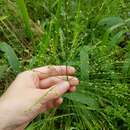Comprehensive Description
provided by North American Flora
Panicum megiston Schultes, in R. & S. Syst. Veg. Mant. 2: 248
1824.
Panicum altissimum G. Meyer, Fl. Esseq. 63. 1818. Not P. altissimum DC. 1817.
Panicum elatius Kunth, R6v. Gram. 38. 1829.
Panicum tuberculatum J. Presl, in Presl, Rel. Haenk. 1: 307. 1830.
Panicum Equisetum Nees; Doell, in Mart. Fl. Bras. 2 2 : 206, as synonym. 1877.
Plants perennial ; culms tall and robust, glabrous ; leaf -sheaths papillose-hispid or papillose only; ligule fimbriate, about 1.5 mm. long; blades firm, ascending, 15-40 cm. long or more, 1.5-3 cm. wide, linear-lanceolate, slightly narrowed to the rounded base, glabrous; panicles finally exserted, 40-60 cm. long, the stiff main axis striate-angled, smooth or scabrous, the branches in distant verticils, often as many as 20-30 in a verticil, 10-20 cm. long, slender, stiffly or sinuously ascending, very scabrous, nearly simple, bearing the scattered, short-pediceled spikelets along the upper half or third; spikelets usually purplish at maturity, about 3.4 mm. long, 1.5 mm. wide, globular-obovoid, glabrous; first glume scarcely one third the length of the spikelet, pointed ; second glume slightly shorter than the sterile lemma, both abruptly apiculate, 7-9nerved, the glume about equaling the fruit, the sterile palea rather firm, about as long as the fruit; fruit 2.8 mm. long, 1.4 mm. wide, abruptly pointed, smooth and shining.
Type locality: British Guiana. Distribution: Cuba; Mexico to Paraguay.
- bibliographic citation
- George Valentine Nash. 1915. (POALES); POACEAE (pars). North American flora. vol 17(3). New York Botanical Garden, New York, NY

